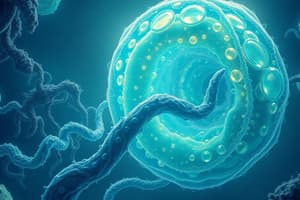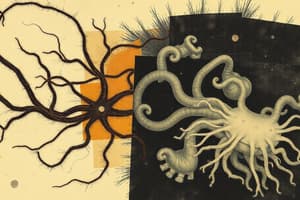Podcast
Questions and Answers
What is the primary source of infection in amoebiasis?
What is the primary source of infection in amoebiasis?
- Direct contact with infected individuals
- Food contaminated with trophozoites
- Cyst passers (correct)
- Contaminated water
What is the most effective way to prevent the spread of amoebiasis in a community?
What is the most effective way to prevent the spread of amoebiasis in a community?
- Treating all patients with antiamoebic drugs
- Providing everyone with anti-amoebic vaccines
- Screening and treating all food handlers
- Implementing environmental sanitation and personal prophylaxis (correct)
Why is it important to avoid using human feces as fertilizers?
Why is it important to avoid using human feces as fertilizers?
- To prevent the growth of harmful bacteria
- To prevent the transmission of amoebiasis (correct)
- To prevent the contamination of water sources
- To prevent the spread of other intestinal parasites
What is the primary goal of treating patients with amoebiasis?
What is the primary goal of treating patients with amoebiasis?
What is the role of food handlers in the transmission of amoebiasis?
What is the role of food handlers in the transmission of amoebiasis?
What is the primary mode of diagnosis for intestinal amoebiasis?
What is the primary mode of diagnosis for intestinal amoebiasis?
What is the primary mode of infection for Giardiasis?
What is the primary mode of infection for Giardiasis?
What is the characteristic of the stool in Giardiasis?
What is the characteristic of the stool in Giardiasis?
What is the diagnostic stage of Giardiasis?
What is the diagnostic stage of Giardiasis?
What is the primary site of attachment of Giardia lamblia in the human body?
What is the primary site of attachment of Giardia lamblia in the human body?
What is the treatment of choice for Giardiasis?
What is the treatment of choice for Giardiasis?
What is the result of the attachment of Giardia lamblia to the mucous membrane?
What is the result of the attachment of Giardia lamblia to the mucous membrane?
What is the primary role of di-iodohydroxyquine in the treatment of amoebiasis?
What is the primary role of di-iodohydroxyquine in the treatment of amoebiasis?
What is the primary treatment for serious hepatic amoebiasis or when an abscess develops?
What is the primary treatment for serious hepatic amoebiasis or when an abscess develops?
Which drug is concentrated in the liver and is used only for the treatment of hepatic amoebiasis?
Which drug is concentrated in the liver and is used only for the treatment of hepatic amoebiasis?
What is the primary treatment for acute dysentery?
What is the primary treatment for acute dysentery?
Which of the following antibiotics is used in combination with di-iodohydroxyquine for the treatment of amoebiasis?
Which of the following antibiotics is used in combination with di-iodohydroxyquine for the treatment of amoebiasis?
What is the primary role of Diluxanide furoate in the treatment of amoebiasis?
What is the primary role of Diluxanide furoate in the treatment of amoebiasis?
Flashcards are hidden until you start studying
Study Notes
Life Cycle of Entamoeba
- Entamoeba life cycle begins with the ingestion of a quadrinucleate cyst through contaminated food or water
- The cyst excysts in the small intestine, releasing a trophozoite
- Trophozoites multiply by binary fission in the lumen of the large intestine
- Some trophozoites attach to the mucosa of the large intestine and invade the intestinal tissue
- Invaded trophozoites produce histolytic enzymes, leading to the formation of flask-shaped ulcers
- Trophozoites in the base of the ulcer continue to multiply and eventually encyst
- The quadrinucleate cyst is passed out in the stool
Pathogenesis and Epidemiology
- Pathogenesis depends on parasite virulence, host resistance, and condition of the intestinal tract
- Cyst passers are the main source of infection
- Cysts remain viable in faeces for a few days and in water for longer periods
Clinical Syndrome and Diagnosis
- Asymptomatic: parasite in lumen and cysts pass in stool
- Symptomatic: intestinal amoebiasis, fever, diarrhea, dysentery, abdominal pain, localized abdominal tenderness, painful spasm of anal sphincter
- Diagnosis: clinically, dysentery, and lab diagnosis through identification of trophozoites or cysts in stool
Extra-intestinal Amoebiasis
- Amoebic hepatitis or amoebic abscess, lung abscess, brain abscess
- Complications of intestinal amoebiasis
Giardia Lamblia (Intestinalis)
- Habitat: duodenum, upper part of small intestine, bile ducts, and gall bladder
- Infective stage: cyst
- Diagnostic stage: trophozoite and cyst
- Mode of infection: contaminated food or water, flies, and food handlers
- Life cycle: longitudinal division, enter with food, and attach to duodenal mucosa
Clinical Syndrome and Diagnosis of Giardiasis
- Asymptomatic carrier: cyst passer
- Symptomatic: duodenitis, epigastric pain, abdominal pain, vomiting, steatorrhea
- Diagnosis: identification of cysts or trophozoites in feces
Trichomonas Vaginalis
- Geographical distribution: worldwide
- Common sexually transmitted protozoan
- Laboratory diagnosis: direct stool examination, aspirate or biopsy from liver, and serology
Treatment of Amoebiasis
- Acute dysentery: metronidazole, tinidazole, and antibiotics
- Carriers: diloxanide furoate, di-iodohydroxyquine
- Hepatic amoebiasis: metronidazole or tinidazole combined with chloroquine phosphate, emetine hydrochloride in severe cases
Studying That Suits You
Use AI to generate personalized quizzes and flashcards to suit your learning preferences.





